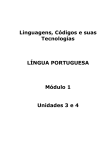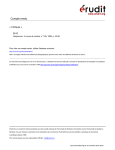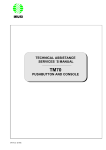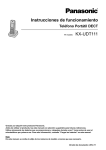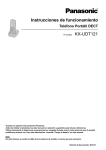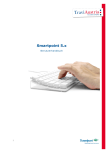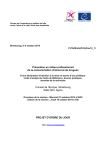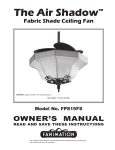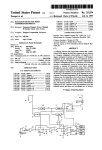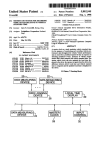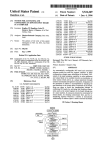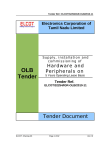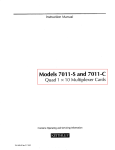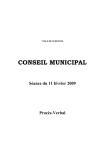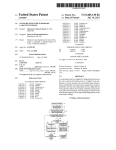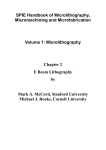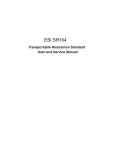Download I : i `. g 1 1. ,1,
Transcript
United States Patent [191 [11] Patent Number: I Quinn et a]. [54] [45] DIAGNOSTIC CATHETER WITH MEMORY [75] Inventors: Michael D. Quinn; Mark L. Yelderman, both of Plano, Tex. Date of Patent: Feb. 24, 1998 0 417 731 3/1991 E‘lmPea? Pal- Off- - 8505475 5/1985 WIPO . W091/03203 [73] Assignee: Baxter International Inc" Dccr?eld’ 5,720,293 3/1991 WIPO OTHER PUBLICATIONS "I‘ranstracheal Doppler: A New Procedures for Continuous 111' [21] Appl‘ No‘: 245’727 Cardiac Output Measurement”, Abrams et a1, Anesthesiol ogy, vol. 70, No. 1, Jan. 1989, pp. 134-138. “A Thermoelectric Blood Flow Recorder in the Form of a [22] Filed: Needle”, Gibbs, 1933, V01. 41, pp. 141-146. May 18, 1994 “Measurement of Cardiac Output in Anaesthetized Animals By a Thermo-Dilution Method”, Fegler, Quarterly Journal Related US. Application Data of Experimental Physiology 195, vol. 39, pp. 153-164. [63] [51] [52] [58] Continuation-impart of Ser. No. 769,536, Oct. 1, 1991, abandoned, which is a continuation-in-part of Ser. No. (List continued on next page.) 647,578, Jan. 29, 1991, abandoned, and a continuation-in patt No. 49,231, Apr. 19, 1993, which is a continu. of _. Ser. _ anon in part of Ser. No. 647,578, Ian. 29, 1991, abandoned. Int Cl.6 ...................................................... .. A6115 5/02 Prima ry Emmmer - __R0bertL. Anomex Agent, or Fi Nasser :blon’ Spivak, Mcclelland, Maier & Neustadt; Bruce Canter US. Cl. ......................... .. 128/692; 128/713; 128/736 Field of Search ................................... .. 128/692, 713, [57] 123/673-5, 691-4, 632-15, 627 _ [56] transducer (110) associated therewith for directly measuring Refennces Clted _ _ m US P 3,075,515 1/1963 3,359,974 12/1967 3’5951079 g’gg’ggg 3’746’O03 31196910 3:793:967 physiological parameters of a patient or measuring an cm IENT DO amount of a parameter indicative of a physiological condi S tion of the patient and a memory (102) which resides at a predetermined location on said catheter (100). The memory (102) contains encoded calibration information for calibrat 7,1971 ing the transducers (110) and encoded patient speci?c infor mation which can be accessed by an external processing system to which the catheter assembly is connected for processing. The memory (102) is further designed such that disconnection of the catheter assembly from the external 7,1973 2/1974 3/1974 3,995,623 12/1976 4,073,287 2/1978 4,089,336 5/1978 4,091,813 4,135,632 ABSTRACT A catheter assembly having a catheter (100) with at least one processing system does not cause values stored in the memory to be lost so that the patient speci?c information need be reentered into the memory when the catheter assembly is reconnected to the same or another external 5/1973 1,1980 (List continued on But page_) processing system. By so providing the catheter assembly with memory (102), information for factory calibration, patient calibration and historical patient data may be stored FOREIGN PATENT DOCUMENTS with the catheter (100) for ease of use. The data in the memory (102) may also be coded to prevent easy replication 0221357 0 235 an 0 303 757 0 378 234 5/1987 European Pat on . 9/1987 E Pat O? 2/1939 European Pat on 7/1990 European Pat. 01f. . of the catheter (100) by a competing manufacturer. 64 Claims, 3 Drawing Sheets 1r’ Z?uFrZ/?a? "11 IF _ _ 1,07,,- _ 756/5665?‘ l | I I I | I | I k //0\€ l| w g /N i :l 1 ' i 1 l‘ 1 1. | L. ____ __ _ _! i I cm : | I I | | | | ‘. /02 I' 1 l l>m I| mun/72R I l I06 L; 1l ,1, |_ __________ __ __ J 5,720,293 Page 2 US PATENT DOCUMENTS 5,214,267 5/1993 Hoshi et a1. .......................... .. 219/497 5,217,019 6/1993 Hughes 128/668 4,198,957 4/1980 Cageetal. ............................ .. 128/1 R 5,261,411 11/1993 Hughes 123/663 4,199,816 4206759 4/1980 Humphrey 6/1980 Shaw ----- -- 5,277,191 5,383,874 4,207,896 4,209,017 6/1980 Shaw 6/1980 Shaw ---- -- 364/571 1215/3031 l/1994 Hughes ...... .. 128/692 1/1995 Jackson et a1. ......................... .. 606141 128/303.1 128/303.1 OTHER PUBLICATIONS 4,236,527 12/1980 Newbower et al. 128/692 4,240,441 12/1980 Khalil ............... .. 1281692 311111165 011 111C 968911011011 °f Red B10011 Cells , Ham @141’ .... .. 364/571 128/303.1 ---- -- 123/736 Blood, vol- 3, 1948, pp- 373-403 ‘Thin Film 'I'hennistors”, Morris et al, Journal of Physics Engineering: Scientific Instruments, vol. i, 1975, pp. 4,303,984 12/1981 Houvig 4,364,390 12/1982 Shaw .... .. 4,399,323 3/1933 Donnell)! 4,407,298 10/1983 Lentz etal 128/713 4,418,392 “[1983 H?“ ----- -- - 364/571 4,446,715 4,481,804 4,499,547 5/1984 Bailey .......... .. 11/1984 Eberhard et a1 . 2/1985 Inulya etal 4,499,907 4,507,974 2,1985 Kallok etal 4/1985 Yelderman 4,524,264 6/1985 Takeuchi et a1 4,572,206 2/1986 Geddes et al 4,576,182 4,611,304 .. 73/1 R .. 73/1 G . 364/571 128,786 73/861.06 .... .. 219/497 “ , _ ” 411_414_ “Shape and Shape Transformations of Heated Human Red Cells 99 , Ponder, J. Exp. 8101., vol. 26, 1950, pp. 35-45. “In stantaneous . . . and Contmuous Cardiac Output Obtained . ,, wlth a Doppler Pulmonary Artery Catheter Segal et al. Ew?mmwl Studies, JACC v01- 13, NO- 6, May 1989,1111 1382-1392 128/692 ‘The In?uence of Temperature on Red Cell Defonnability”, 3/1986 Norman ....... .. 9/1986 Butenko et a1. . 128/692 . 364/571 Williamson et al., Blood vol. 46, No. 4 Oct. 1975, pp. 611424 4,621,643 "/1986 New/1L 9‘ 91 4,632,125 “"986 weblm‘ “1- 4,671,295 6/1987 Abrams a al. 4 684,245 8/1987 G01dn-ng 128/633 12%” 128/663 356/41 ‘The Output of the Heart in dogs”, Stewart, The American Journal ofPhysiology v01. 57, 1921, pp. 27-50. . . A Continuous Cardlac Output Computer Based on Ther 4:685’470 8/1987 Sekii 4,700,708 10/1987 New, Jr. etal. 128,692 128/633 modilution Pl'lllClPICS, R-A. NOHIIBIIH Ct 31., Annals Of Biomedical Eng” vol- 111111-6143, 1989 4,708,777 11/1987 Knraoka ,,,,,,, __ 4,718,423 111988 Willis et a1. 4,722,347 2/1983 Abrams at 81. 204/1 T .... .. 128/634 ---- -- 128/663 Investigation of a Continuous Heating/Cooling Technique for Cardiac Output Measurement, Kevin C. Ehlers et al., Annals of Biomecial Eng., vol. 15, pp. 551-565, 1987. 4,733,669 . . . . .. 4,759,378 4’770’179 4,785,823 4,796,640 . - . . . . . .. . .a . . .a . . 7/1983 Swendson =1 919/1988 New’k' eta] Cardiac 128’786 "" “ 122%” Estima?on a Thmnod?u?on Method Involving Intravascular Heating and Thermistor Recording, T. Barankay et al., Acta Physiologica Academiae Scien 11/1988 Eggers et al 128/692 128,736 tlarum Hungarlcae, Tomus 38(2-3), pp. 167-173, 1970. 1,1989 webla . . 4 814,586 3,1989 Gdse ____ " 219,549 Measurement of Cardiac Output by Thermal-Dilution and ‘£319,655 411939 ‘Namer __ 128,713 Direct Fick Methods in Dogs, H. H. Khalil et al., Journal Of 4,832,504 4,841,981 5/1989 Hori et a1 . 6/1989 Tanabe et a1. . 374/183 1281692 APP1-PhyS1°1-,V°1-21(3),PP- 1131-5 1966 Determination of Cardiac Output in Man by a New Method 4,856,530 4,858,615 8/1989 Vandervelden 8/1989 Meinema 128/692 1281668 Based on Thermodilution, H. H. Khalil et 81., Preliminary Communications, Jun. 22, 1963, pp. 1352-4. 15135:?“ ’ ’2 ' '' e? at '' ' Repeated or Continual Measurements of Cardiac Output in 128/692 the Squirrel Monkey (Saimin' sciureus) by Thermodilution, 4,901,734 2/1990 Gn?in et al 7/1990 w?nams et 31 128,692 H. H. Khalll, Bureau of Med. and Surgery, MR011.01.4, 4,942,877 4,947,852 7/1990 8/1990 Nassi Sakai et er 21 al 128,633 123/661 Naval CRC A?'OSp?CC Handbook MCd of Chemistry 11151;, M31’. and 8, Physics, 60th 1341., 4,951,682 8/1990 Peue ........... .. 1281713 1979-1980, p. 13-85 Cole-Parmer Instrument Co., Niles, I1, 4,954,318 5,007,423 9/1990 Yafuso et a1. 4/1991 Bmstmret 91- 422/59 128/633 (Catalog pp. 1259-61). Baxter healthcare Corp., (Catalog pp. 1, 2, 5 and 6) Jun. 1992 Service Manual for Model COM-1 Thermodilution 4,941,475 gag/2g 31131 316;; ---- a--------- ’ ’5 5,047,025 5,056,526 a ' ' 9/1991 Tayloret a1. . 10/1991 Khalil ...... .. . Cardiac Output Computer, American Edwards Laboratories, 606/31 128/692 5,030,106 111992 Saki etal _ 123/692 5,121,749 6/1992 Nassi e131 , 123/692 5,158,082 10/1992 Jones ..................................... .. 128/633 J “11' 1984 _ 6 Tabl 2 1 ’P- ’ 8 ‘ - _ “Continuous Thermal Measurement of Card1ac Output”, Philip et a1, Transactions on Biomedical Engineering, vol. SME-31,No. 5, May 1984, pp. 393-400. US. Patent Feb. 24, 1998 Sheet 1 0f 3 5,720,293 QR _ :5r7 Fl?1n|wmk_wzmw |_ _ _ _ _ _ _ _ _ _ _ _ _ _ _ _ _ US. Patent Feb. 24, 1998 Sheet 3 of 3 5,720,293 5,720,293 1 2 DIAGNOSTIC CATHETER WITH MEMORY output computer. However, the device of Lentz et al. simply uses individual “bit” lines, each of which can be either open or closed so that four different coded states re?ecting the size CROSS-REFERENCE TO RELATED of the catheter are possible, and does not relay information about the transducers themselves to the output computer. While Lentz et al. do not describe that information about the transducers may be contained on the catheter, other prior APPLICATIONS This patent application is a continuation-in-part applica tion of U.S. patent application Ser. No. 07/769,536 to Quinn et al., ?led Oct. 1, 1991, now abandoned, which was originally a continuation-in-part application of U.S. patent application Ser. No. 07/647,578 to Quinn et al., ?led Jan. 29, 1991 now abandoned. This patent application is also a art catheter sensors utilize a memory unit which is connected 10 continuation-in-part application of U.S. patent application to the sensors and to signal processing circuitry. For example, Meinema describes in U.S. Pat. No. 4,858,615 an integral sensor and memory combination unit where infor mation regarding the characteristics of the sensor or sensor Ser. No. 08/049321 to Quinn et al., ?led Apr. 19, 1993, memory combination are permanently recorded in the which is a continuation application of U.S. patent applica memory and the sensor and memory are indissolubly tion Ser. No. 07/647,578 to Quinn et al., ?led Jan. 29, 1991, now abandoned, and which is hereby incorporated by ref coupled together. The recorded information (such as data for linearizing the sensor outputs) is automatically read and erence as is if fully set forth herein. retrieved by separate electronic processing circuitry. However, the system of Meinema is described only for transducers which receive naturally occurring physiological BACKGROUND OF THE INVENTION parameters and is not described for use with transducers which measure responses to energy or outputs from other 1. Field of the Invention The present invention relates to a diagnostic catheter for insertion into the bloodstream of a patient, and more particularly, to a diagnostic catheter with an integral memory introducing type transducers. In addition, Meinema corrects the transducer responses for both amplitude and o?set and is concerned only with displaying a corrected physiological device which contains factory calibration and factory iden parameter. As a result, Meinema does not consider correct ti?cation information, software program segments, patient 25 ing or modifying the transducer for calculation, estimation, speci?c calibration information, historical information and or computation of derived measurements. Furthermore, the like which is not lost when the catheter is disconnected Meinema gives no consideration to correcting, modifying, from its associated display device. 2. Description of the Prior Art Diagnostic catheters have been constructed in various via introduction transducers. It is thus desirable that sensor/ con?gurations and used in medicine for a multitude of purposes. Such catheters are designed to reside within expanded to include the above-mentioned capabilities as well as other capabilities to be described in the following lumens, chambers, ori?ces and tissues of various organs, including arteries, veins, the heart and the like. Medical catheters have been used as conduits to either infuse ?uids or drugs or as conduits for connecting intra-vascular or organ ?uids to transducers for measuring pressure, ?ow, temperature, oxygen saturation and the like. Catheters have also been used to assist in blood circulation as described, for example, by Rishton et al. in U.S. Pat. No. 3,720,199, which relates to an intra aor1ic balloon catheter assembly which is implanted in the descending aorta and connected to instru mentation to in?ate/de?ate the balloon synchronously with the cardiac cycle. Medical catheters also have been constructed such that transducers can be mounted directly on the catheter, either at the tip, on the surface, or within the catheter body, for measuring physiologic parameters and sending the informa compensating for energy, indicating or delivering substances memory systems of the type taught by Meinema be 35 detailed description of the invention. Non-catheter based measuring systems frequently have provided correcting means comprising memories for storing correction data. For example, Hata desrribes in U.S. Pat. No. 4,418,392 a measuring device having a measurement cor recting module with a memory unit for storing correction data which is used to correct digitized transducer data However, this system requires the measured data to be altered at the analog to digital converter. It is desired that such modi?cations of the raw data be avoided to ensure accuracy. Similarly, Bailey describes in U.S. Pat. No. 4,446, 715 using correcting means responsive to calibration means for correcting the measured physical variable. This is done for pressure transducers which are not catheter based by using information from a ROM (Read Only Memory) to correct the transducer output without any incorporation of tion directly to a monitor or display device. Such transducers 50 the information into a microprocessor program. However, as include catheter mounted thermistors for measuring temperature, pressure transducm's for measuring hydrostatic with the system of Hata, this system requires the raw data to be modi?ed. Other disclosures directed to calibration of non-catheter based sensors using a memory device include U.S. Pat. No. However, for particular catheter-mounted transducers, 55 4,481,804 to Eberhard et al.; U.S. Pat. No. 4,499,547 to Inuiya et al.; U.S. Pat. No. 4,611,304 to Butenko et al.; U.S. certain errors are present. Some errors are inherent in the Pat. No. 4,868,476 to Respaut; and U.S. Pat. No. 4,942,877 design of the transducer; some are caused by variations in pressure, and oximeters for measuring blood oxygen satu ration. are caused by changes in the transducer due to aging or use; and some are patient speci?c. Although such errors can be to Sakai et al. New, Jr. et al. describe in U.S. Pat. Nos. 4,770,179, 4,700,708 and 4,621,643 an oximeter with a calibration system; however, this system uses a resistor to measured, several practical problems arise. For example, code the LED information for the pulse oximeter. Similarly, the transducer as a result of manufacturing processes; some Vandervelden in U.S. Pat. No. 4,856,530 describes a cali bration system using a capacitor to store the calibration information. conveyed to either the end user or to a monitor or measming In addition, although errors which arise once the trans device so that the errors may be compensated. For example, 65 ducer is in use, either because of aging or other processes of Lentz et al. describe in U.S. Pat. No. 4,407,298 a connector the transducer or because of patient physiological variations, for a therrnodilution catheter which joins the catheter to an although design or manufacturing errors can be measured for each individual transducer, that information must be 5,720,293 3 4 can be measured by in vivo or patient calibration tests, again the results must be retained by the measuring device or No. 5,146,414 to McKown et al., both of which have been assigned to the same assignee as the present invention. In accordance with the techniques set forth in these patent applications, several parameters are measured, such as tem perature (using a thermistor or thermocouple), cardiac out put (which requires the transfer of indicator from a trans ducer such as a heater ?lament to the ?owing blood and the measurement of the response at the distal thermistor) and monitor for display to the end user. Moreover, a more serious problem is that the transducer, once inserted in a patient, cannot be removed. Rather, the inserted transducer must move with the patient. Nevertheless, when the patient is moved from one critical care environment to another, such as from the operating room to the intensive care unit, the monitoring equipment is often not moved, but rather the catheter is disconnected from the original monitor and 10 reconnected to another monitor in the new location. Such absorbance). Accordingly, preferred embodiments of the disconnection typically results in the loss of transducer invenn'on will be described for use with such devices. speci?c or patient speci?c information or requires the opera In particular, the present invention relates to a device for tor to re-enter the information, resulting in inn-eased work, frustration, and reduction in quality of patient care. Another problem for catheter manufacturers is that gen gathaing physiological data from a patient and supplying the gathered data to a processing system. Preferably such a device in accordance with the invention comprises at least one transducer for directly measuring physiological param erally the ca?reter is relatively simple in proportion to the complexity of the computing, calibration and display devices, yet the pro?ts are made from the sale of the catheters, not the monitors. As a result, even though a 20 manufacturer may develop, manufacture, and sell the cath eter and display device as a system, the catheter can be easily replicated by a competitor and manufactured and sold with out the display device, resulting in a signi?cant loss of profits for the original manufacturer. This can be somewhat prevented if the catheter and display device have some mechanism by which a competing manufacturer may be rn'evented from copying the catheter alone and selling it in place of the original catheter. A suitable mechanism of this type is desired. Previous inventors have addressed this problem by designing various types of devices for encoding transducer factors for calibration. For example, Houvig in US. Pat. No. 4,303,984 places in a common connector a ROM, shift register and other sensor electronics powered by a power supply which is also included in the same connector. In the Houvig device, when the ROM information is desired, the oxygen saturation or oxirnetry (which requires the transmis sion of two or more appropriate wavelengths of light into the blood or tissue and the detection of light re?ection/ 25 35 eters of the patient or measuring an amount of a parameter indicative of a physiological condition of the patient, and a memory which resides at a predetermined location with respect to the at least one transducer. Preferably, the memory contains calibration information for calibrating the trans ducer and patient speci?c information which can be accessed by the processing system to which the device is connected for processing. Preferably, the memory is selected such that disconnection of the device from the processing system does not cause values stored in the memory to be lost so that the patient speci?c information need be reentered into the memory when the device is reconnected to the same or another processing system. Also, in order to prevent piracy, it is preferred that the stored data be encoded. Preferably, the device of the invention is a catheter assembly and the transducers are disposed on or about the catheter. The memory of the invention may be disposed at different locations within the catheter assembly. For example, the memory may be disposed within the body of the catheter, in an area adjacent one of the transducers or in a connector connected to a proximal end of the catheter information is “clocked” from the ROM and is combined or superimposed onto the raw sensor electronics. However, assembly for allowing at least one transducer of the catheter to communicate with the processing system. which may be a conventional external. processing system or computer. Such a connector preferably comprises leads which are such an arrangement is unduly complicated and expensive for use in a diagnostic catheter of the type to which the present invention is directed. A simpler and less expensive alternative is desired connected to the memory so as to allow access to contents Accordingly, it is desired to provide a catheter with 45 of the memory by the external processing system connected memory which can overcome the above-mentioned prob to the catheter. lems by retaining the information speci?c to factory The catheter of the invention may be of di?’erent types and calibration, patient speci?c calibration data, historical may include transducers of di?’erent types. For example, the patient data and the like. It is also desirable that this catheter may be designed for single patient use or multiple information be coded to prevent unauthorized access. The 50 patient use. Also, the transducers of the catheter preferably present invention has been designed to meet these needs. comprise a ?rst transducer for introducing energy or a SUNIMARY OF THE INVENTION The above-mentioned and other problems of the prior art are resolved in accordance with the present invention by providing a catheter apparatus with an integral memory for 55 physical indicator into a physiological medium of the patient and a second transducer for directly measuring physiological parameters of the physiological medium in response to the energy or physical indicator which has either passed through the physiological medium or passed directly from the ?rst calibration data, patient historical data, encoded data and the like. For example, a presently preferred embodiment of the transducer to the second transducer. In a particular embodiment, the ?rst transducer may be a heating element and the second transducer may be either a invention relates to a multilumen ?ow directed pulmonary thermistor or a thermocouple for measuring temperature artery catheter which has associated therewith one or more changes in the physiological medium caused by the heating element. In this embodiment, the heating element is prefer retaining information speci?c to factory calibration, patient transducers for measuring different transducer and physi ological parameters of the patient when the catheter is placed in various vessels, lumens. bladders, ori?ces, cham ably made of a thin, ?exible material which may be wrapped either on the exterior of the catheter body wall and then bers and other body spaces of the patient. Such a system is covered by an external sheath material so that the heating described by way of example in the aforementioned parent application for use with the processing circuitry of US. Pat. element material is not exposed to the blood or on the outer surface of a supporting sheath inserted into the catheter 5,720,293 5 6 lumen. During use, the heating element temperature is preferably measured simultaneously with the thermodilution an intra-cavity catheter or an organ contact catheter. On the other hand, the memory of the invention may also be used in non-catheter applications such as topically applied sen sors including pulse oximeters, transcutaneous oxygen elec trodes and the like. In one preferred embodiment, wherein the catheter has a heating ?lament and a temperature detecting means, cali brating means are provided for calibrating both the heating filament and the temperature detecting means. Preferably, the calibrating means comprises a Read Only Memory (ROM) contained within the catheter member for storing calibration information for either or both the heating ?la measurement without the use of a second measuring trans ducer. The heating element temperature is not measured to calculate velocity, but rather to insure that a safe heating element temperature may be maintained. This is accom plished in one embodiment by forming the heating element of a material which has a resistance proportional or inversely proportional to its temperature. On the other hand, the ?rst transducer may supply thermal energy, ultrasound or electromagnetic energy to the physi ological medium and the effects thereof on the physiological medium may be measured by the second transducer for use by the external processing system to measure blood ?ow, cardiac output and/or ?ow of another physiological sub stance of the patient. In addition, the ?rst transducer may supply optical energy to a physiological medium of the patient and the effects thereof on the physiological medium may be measured by the second transducer for use by the external processing system to measure oxygen saturation, ment and the temperature detecting means, as well as any other necessary information. Preferably, the ROM is located at the proximal end of the catheter and includes calibration information relating to heating ?lament resistance at a given temperature, heating ?lament heat transfer e?iciency, tem perature coe?icient of resistance and thermistor information. Moreover, the ROM may be connected to a cardiac output computer so as to pass a program segment, stored in the ROM, of a program used by the cardiac output computer to oxygen tension (PaO-z), pH level, PCO2 concentration, elec trolyte concentration (e.g., sodium, potassium, chloride, bicarbonate and glucose) and the like. However, the detec tion transducers used in accordance with the invention may measure naturally occurring substances, parameters, or other physiological events which have not. been supplemented calculate cardiac output of the patient, whereby calculation of the patient’s cardiac output cannot commence until the cardiac output computer is connected to the ROM and the 25 mation including manufacture date, batch number, steriliza tion date, expiration date, catheter transducer number and with an energy or other type of introduction transducer such as a tempm'ature, pressure, or ion concentration transducer. Accordingly, the technique of the invention is not limited to use with heat (temperature), optical energy or indicator type transducers. 30 ‘ In accordance with another aspect of the invention, the connector leads are connected such that the external pro cessing system can write calibration information to the memory of the catheter during operation for in vivo cali bration. This information may then be used during process program segment transferred to the cardiac output computer. In accordance with yet another aspect of the invention, the memory may further contain catheter identi?cation infor type, manufacturer’s name and address and any other unique identi?cation or process information. In addition, the memory may also contain a computer program, a computer program segment, a software subroutine and computer memory addresses which can be read by the external pro cessing system and used thereby to verify, correct, or modify 35 the processing of the catheter transducer information. In such an embodiment, the software of the catheter memory and the external processing system together form a unique software combination such that system operation cannot ing of the detected data to make necessary corrections or modi?ciations to the transducer outputs or the subsequent occur without the two software pieces together. This assures computations using the raw information received from the transducers. that only catheter memories programmed by particular access the patient speci?c information in the memory via the manufacturers can be used with a particular processing system. For this purpose, the memory may further contain a proprietary code which is read to determine whether the connector leads so that the memory may provide historical catheter assembly is supplied by a particular manufacturer. During operation, the external processing system may patient information to the external processing system for display as trending data of the patient. This information is maintained such that even when the catheter assembly is BRIEF DESCRIPTION OF THE DRAWINGS The above and other objects and advantages of the disconnected from the external processing system the invention will become more apparent and more readily patient’s historical data can be later retrieved when the appreciated from the following detailed description of the presently preferred exemplary embodiment of the invention taken in conjunction with the accompanying drawings, of 45 catheter assembly is reconnected to the same or another external processing system. For this purpose, the catheter assembly may further comprise a battery located in prox imity of the memory for providing power to the memory 50 which: FIG. 1 illustrates a calibration circuit having a memory in accordance with a presently preferred embodiment of the when the memory is not connected to the external process invention. ing system. In addition, the calibration information and patient speci?c information are preferably encoded in accor 55 dance with a proprietary code stored in the memory. This proprietary code may then be read by the external processing system to determine whether the catheter assembly is sup plied by a particular manufacturer prior to conducting fur ther processing. Preferably, the proprietary code is a binary code stored in the memory and is accessed by the external processing system and used thereby to decode the encoded CAT93C46 1 Kbit Serial EEPROM. FIG. 3 and 4 respectively illustrate top and side views of the catheter connector assembly at the proximal end of a catheter having a memory in accordance with the invention. FIG. 5 illustrates an end view of a connector cover for covering the catheter connector assembly shown in FIG. 3. calibration information and encoded patient speci?c infor mation. In preferred embodiments of the invention, the catheter may be either an intra-arterial catheter, an intra-venous catheter, an intra-chamber catheter, an intra-ori?ce catheter, FIG. 2 illustrates in more detail the connections of the memory of FIG. 1 for the case where the memory is a 65 DETAILED DESCRIPTION OF THE PREFERRED EMBODIMENT A system with the above-mentioned bene?cial features in accordance with presently preferred exemplary embodi 5,720,293 8 7 ments of the invention will be described below in detail with reference to FIGS. 1-5. Although the present invention is i AP . p described for use with a thermodilution catheter in the prefm-red embodiment, it will be appreciated by those of ordinary skill in the art that the description given herein is where Ap is the change in the coe?icient and for exemplary purposes only and is not intended in any way to limit the scope of the invention. All questions regarding the scope of the invention may be resolved by referring to AT is the change in tempm'ature, then: the appended claims. In a preferred embodiment. a therrnodilution catheter has a heating ?lament which resides internal to the catheter ' body, either in a preformed catheter lumen or beneath an outer sheath, and which preferably does not directly contact the blood. The heating ?lament is preferably made of a thin, ?exible material which may be wrapped either on the exterior of the catheter body wall and then covered by an Then, by measuring the current (i) and the voltage (v), both delivered power and resistance of the ?lament can be simultaneously measured as: external sheath material so that the heating ?lament material is not exposed to the blood or on the outer surface of a supporting sheath inserted into the catheter lumen. The heating ?lament so designed supplies a quantity of heat to the ?owing blood which is used for measuring the volumet 20 ric blood ?ow using an indicator dilution equation. In a preferred embodiment the heating ?lament is comprised of heating ?lament in the form of pulses. When the heating a material having a high temperature coe?icient of resistance, whereby resistance of the heating ?lament is inversely proportional to its temperature (i.e., it has a negative temperature coe?icient of resistance). This aspect 25 may continuously measure and monitor the ?lament tem perature so as to limit the peak ?lament temperature to a maximum of 52° C. (which corresponds to a peak surface temperature of about 48° C. and an average surface tem temperature of the heating ?lament reaches approximately 52° C. A material suitable for the heating ?lament thus has a temperatm'e coe?icient of resistance greater than 0.001 QlQ-° C. Also. such a material preferably has a low thermal capacitance and high thermal conductivity. Preferred heating 35 temperature sensing device. For example, resistance of any material is measured as follows: p is the resistivity, l is the length, and perature of about 44° C., depending upon the material composition and thickness). For example, in the event the heating ?lament temperature exceeds 52° C. for more than, say, 15 seconds at full power, the delivered heating ?lament power is reduced. Then, if the heating ?lament temperature exceeds 52° C. for more than, say, 15 seconds at reduced power, the heating ?lament power may be shut off and a panel alarm activated. This prevents the peak surface tem perature from exceeding 48° C. Moreover, the average catheter surface temperature should not exceed 44° C. since the power will be switched “ON” approximately 50% of the time. Furthermore, if the average cardiac output exceeds 3.5 liters/minute, the catheter’s average surface temperature will generally remain below 44° C. Thus, regulation of power to the catheter only becomes an issue when the cardiac output becomes less than about 3.5 litms/minute. However, since as a thermistor or thermocouple would need to be embedded next to the ?lament to measure its temperature. However, by using a ?lament material which has a high temperature coe?icient of resistance as herein described, not only can it be used as a heat supplier, but it can also serve as its own ?lament is activated, an approximate average of 7.5 watts of power may be delivered to the heating ?lament. During operation, as described above, the cardiac output computer of the invention enables power to the heating ?lament to be reduced when resistance of the heating ?lament exceeds a predetermined resistance amount, which is reached when the ?lament materials include an alloy of approximately 70% nickel and 30% iron and an alloy of approximately 29% nickel, 17% cobalt and 54% iron. During operation, since the heating ?lament formed as described above is used primarily to insert heat into the blood stream. it will rise to a temperature higher than the surrounding environment Thus. it is necessary to know the ?lament temperature since, should the temperature become excessive, damage could result to the surrounding blood and tissues. Normally, a second temperature sensing device such When a therrnodilution catheter in accordance with the invention is connected to a cardiac output computer via a heater connector, an electrical current is applied to the the power to the heating ?lament is reduced or shut off as the 50 ?lament temperature reaches 52° C., the heating element of the invention can be made relatively fail-safe through closed-loop control of the surface temperature. By using a power source which is a constant voltage source, an increasing catheter ?lament temperature can be directly detected as an increasing ?lament resistance which reduces the powm' delivered to the heating ?lament. In this 55 manner, the actual current and voltage to the catheter ?la ment may be continuously monitored. From the values of current and voltage, a delivered power may be calculated which is needed to calculate ?ow, and the ?lament resistance may be calculated and used for computing the ?lament A is the cross-sectional area. temperature. Thus, at all times, the actual ?lament tempma Then: ture is known. In the calculation of cardiac output using a therrnodilution catheter and an associated processing system, it is necessary to know certain properties about the measuring transducer, 65 such as a thermistor or thermocouple, and the heat applica and if ct, the mean temperature coe?icient of resistivity, is tion or heating ?lament ef?ciency, for in the manufacturing de?ned as: process it is dif?cult to produce either therrnistors or ther 5,720,293 9 10 mocouples or heating ?laments which uniformly have the cardiac output computer. This feature of the invention also provides an additional safety feature, for the cardiac output same properties. Thus, to reduce the errors which would be introduced into the calculation of cardiac output due to these variances, it is necessary to calibrate or measure the physical properties of both the thermistor or thermocouple and the heating ?lament. Since in a clinical environment each car diac output computer may be attached over time to various pulmonary artery catheters and to eliminate the need for the computer will not start until it has transferred the program segment and incorporated this segment into its own pro gram. The calibration circuitry of the type just described can be seen by way of example in FIG. 1. As should be apparent to one of ordinary skill in the art, the calibration circuit of FIG. user to manually transcribe these calibration numbers to the computer, a coding technique has been developed in accor 10 dance with the invention to pass the calibration information. 1 is quite di?’erent from that used in typical prior art thermodilution catheters. In particular, classic thermodilu tion catheters use calibration resistances which are con nected to form one-half of a bridge circuit with the ther mistor or thermocouple. In such devices, the reference resistor is selected to match the thermistor or thermocouple or LEDs. For example, New, Jr. et al. in the aforementioned for a standard temperature. In this manner, compensation for US. Pat. No. 4,700,708 use a resistor to calibrate LED 15 variability in the thermistors or thermocouples may be wavelengths on a pulse oximeter. However, the present achieved. However, by using the calibration circuit of the inventors know of no previous attempt to code the ?lament invention whereby a RAM or ROM containing calibration data is included within the connector of the catheter, such a calibration for transferring the calibration information of the reference resistor for calibration purposes is not needed heating ?lament solely or the calibration information of the , Prior art thermodilution catheters and pulse oximeter sensors have used resistors to code the values for thermistors heating ?lament and thermistor or thermocouple together. Thus, in accordance with the present invention, calibration of the heating element may be conducted by measuring the 20 Such a memory for use with a thermodilution catheter 100 is shown as memory 102 of connector 104 in FIG. 1. Preferably, the software module referred to above is stored in the memory 102 and includes such things as the format version for the calibration data, trademark heater resistance at a known temperature. The catheter assembly can then use the previously calibrated thermistor or thermocouple and a built-in ohm meter to establish a 25 information, historical patient data (such as cardiac output for the previous several hours) or whatever information is calibrated reference point for the heater element. This approach has the advantage of calibrating the heater imme diately prior to use in a patient at the patient’s body desired for controlling the cardiac output program. Thus, by The calibration circuit of the invention may include placing the encoded calibration data within the memory 102 and placing the memory 102 on the catheter 100, the reference resistance 106 for the thermistor or thermocouple 108 may be eliminated. In addition, only a catheter having a memory 102 storing the necessary information for oper ating the program of the cardiac output computer may be passive electronic components such as resistors, inductors used in conjunction with the cardiac output computer to temperature. Such an accurate calibration of heater resis tance and temperature is necessary to accurately monitor heater temperature to insure patient safety. and capacitors such that the value of the components cor respond to a particular calibration value or number accord ing to a predetermined table. On the other hand, active electronic components including numerous nonlinear com ponents may be used such that a particular performance corresponds to a particular calibration number or value. Such calibration information is preferably stored in a memory component such as a ROM (Read Only Memory), 35 of a catheter or catheters such as those described in the aforementioned related application by retaining factory calibration, factory identi?cation, computer or monitor spe ci?c software program segments, patient speci?c calibration information, and patient historical information in the cath eter which is not lost when the catheter is disconnected ?'om the computer, monitor or other display device, as when the _ RAM (Random Access Memory), nonvolatile memory devices or other types of volatile or nonvolatile memory or digital devices of any desired size. The calibration informa tion preferably includes codes that represent the ?lament resistance, ?lament e?lciency, and other parameters. If prop obtain the desired calculation. Thus, the purpose of the present invention as illustrated in FIG. 1 is to disclose a method of enhancing the performance patient is moved. 45 In particular, the catheter of the invention contains in the body, connector, or some other aspect of the catheter a memory 102 which can be accessed by any of a variety of erly selected, one or more electronic components may be means when the catheter is connected to an external pro used to encode the calibration information of the thermistor cessing device such as a cardiac output computer. The or thermocouple, such as its [3 value, and the ?lament 50 memory 102 is either of a volatile or nonvolatile type such resistance, ?lament e?iciency and other parameters. . that when the memory 102 is not connected to the external Thus, the calibration information for both the thermistor or thermocouple and the heating ?lament may be encoded processing device the memory contents are not lost. In addition, the external processing device is preferably by one or more active or passive electronic components or allowed, when connected to the catheter 100 and conse these values may be stored in a suitable memory device. The cardiac output computm' may then decode this information and incorporate it into the calculation of cardiac output, for example. However, this step may be eliminated if the actual 55 quently to the memory 102. to address any byte of the memory 102 and to either read or Write to the byte at that address. In addition, the relevant information can be written to the appropriate address of the memory 102 during the appropriate software is contained in the catheter itself. For example, a memory device such as a ROM may be contained portion of the manufacturing process during which the in the catheter with a portion of the software utilized by the cardiac output computer resident within it. Such information might include program segments or historical patient data. Thus, when the catheter is connected to the cardiac output following information segments: calibration data is measured. In a preferred embodiment of the invention, different segments of the memory 102 may contain any or all of the computer, prior to the beginning of processing for determin ing the cardiac output, the software or program segment contained in the catheter memory device (ROM or RAM) may be transferred to the main software program of the 65 1. A catheter unique serial number; 2. Manufacturing identi?cation data, such as calibration, manufacture, sterilization and ship date or any other date and time information relevant to the catheter 100; 5,720,293 12 11 counterfeit the catheters in which the present invention is used, such as the catheters described in the parent applica tion. For this purpose, an algorithm is used to encode selected bytes of data within the catheter EEPROM. For 3. A software program segment which is not integral to the catheter 100 or to any aspect of the catheter 100 or catheter transducer 110, but is instead program information, such as a subroutine, which is incorpo rated into the software program of the display device; 4. A unique security code which allows the monitor to identify a catheter which has been manufactured by the manufacturer of the monitor or a competing manufac turer; and 5. Manufacture or calibration information about the energy introduction transducer 110 which is the part of the catheter 100 used to introduce energy into the ?owing blood for the therrnodilution measurement. example, in a preferred embodiment the ?rst two (2) bytes of data in the EEPROM need not be encoded. This allows the software of the external processing device to read the security code in those bytes. This code is the basis of an encrypting/decrypting key for the remainder of the stored data. Several other bytes also need not be encoded (such as bytes 02 through 07) and preferably contain product infor mation such as model number and serial number and the like which may also be read by the software of the external processing device. The remaining bytes are encoded and are initialized to contain the manufacturer’s copyright notice and checksums (arithmetic 8-bit sums) which may be used by the security algorithm as shown in TABLE 1 below. Such information could contain, for example, ?lament or transducer nominal electrical resistance, heat trans fer coe?icient. thermal mass, ?lament composition and coe?icient of resistance. Of course, in view of the present disclosure, those skilled in the art will appreciate that other desirable information may be kept in the memory 102 as well. The present invention will now be described in more detail with respect to FIGS. 2-5. The following algorithm is preferably utilized to encode or decode the stored data. First, the security code is read 20 FIG. 2 illustrates a schemah'c for a catheter memory 102 in accordance with a preferred embodiment of the invention. As shown, a standard thermistor/resistor bridge catheter assembly having reference resistor 106 and thermistor 108 25 may be used as in the embodiment of FIG. 1 to measure as follows: blood temperature. Catheter memory 102 is also provided and is connected as shown to include voltage supply lines (VCC), clock lines (SK), data lines (DI and DO), and a ground (GND). In the presently preferred embodiment, a data ‘=((security_eod: & cksum) & ‘security_code)>>4; 30 CAT93C46 l Kbit serial EEPROM is used as memory 102 and is connected as shown, where CS indicates “chip select”, NC indicates “no connection” and ORG indicates “memory organization”. As would be apparent to one skilled in the art, although only one address or “clock line” is shown, any number of lines can be used. Also, as shown in more detail in FIGS. 3 and 4, the address and data lines prefa'ably go to a connector 300, and these address and data lines may be shared with other transducer’s lines, which in from bytes 00 and 01. This code may be, for example, 0314 Hex, but any 16-bit value is possible. The checksurn in byte 127 is then read and ANDed with the security code. This result is then ANDed with the complement of the security code and shifted right four places. This forms the encryption/decryption key. The data to be encrypted or decrypted is exclusive-ORed, on a word basis, with the key. The above may be illustrated by a simple C code expression 35 Also, the information related to factory calibration of the catheter ?lament is preferably stored and read from byte 08. Of course, those skilled in the art will readily appreciate that many other types of known encoding schemes may be used. For example, the proprietary code may also be encrypted in accordance with the invention. The data in a preferred embodiment of memory 102, after initialization, will thus appear as follows: the case illustrated are ?lament heater lines. TABLE 1 FIGS. 3-5 illustrate in more detail the catheter connector 300 of the invention. As shown, the memory or chip 102 is mounted in the proximal end of the catheter at the connector 300. Connector pins 302 are attached to the pins of the memory chip 102 so as to allow the memory 102 to be accessed by an external processing device when the catheter connector 300 is plugged into the external processing device either directly or via a connecting cable. The catheter 45 assembly may further include a connector cover 400 as shown in FIGS. 4 and 5 to protect the memory chip 1 102 from damage. As noted above, in a preferred embodiment of the inven tion the memory 102 is a CAT93C46 1 Kbit serial EEPROM. A CAT93C46 memory device is organized in 64 registers of 16 bits (ORG pin at VCC) or 12.8 registers of 8 bits each (ORG pin at GND). Each register can be written or read serially by using the DI or DO pins. The CAT93C46 00-01 02-05 Unencoded security code Unencoded serial numbe 06 Unencoded layout byte 07 08 09-32 33 34 Unencoded model number Encoded lnater lesistance Encoded remaining data Blooded checkstun of above data Zero byte 35-38 39 40-41 42-82 83 84-126 127 Longword, mrmber of seconds since 1/1/70 Checksum of all above bytes Zero bytes “Copyright (c) 1991 Iuter?o Medical, Inc.” Zero byte Random iminitialized data bytes Checksum of all above 127 bytes Then, for example, the data in the EEPROM, after patient memory device is desirable since it is a CMOS EEPROM data has been collected, will appear as follows: endure 10,000 erase/write cycles and a data retention of 10 years. However, those skilled in the art will realize that other memory devices will satisfy the characteristics of the present invention. TABLE 2 The allocation and use of memory 102 will now be described. In particular, the algorithm used to encode and catheter EH’ROM is to make it more di?icult to copy or Function 55 with ?oating gates, operates at 700 Khz, and is designed to decode the data stored in the EET'ROM of several models of thermodilution catheters will be described. As noted above, the purpose of encoding the data in the Byte 65 Byte Function 34-35 36-37 Pat'wnt Weight Patient Height 38 Reserved 39 40-43 Checksum of above ?ve (5) bytes Timestamp of 1st CO data point 5,720,293 14 (ii) a memory which resides at a predetermined location on or about said catheter, said memory storing ther TABLE 2-continued Byte Function 44-45 46-109 Cotmt of all C0 data points in EEPROM Last 64 CO data points at 15 minute intervals Reserved Checksum of bytes 40 through 110 110 111 This data is the “historical patient data” in a preferred embodiment, although other data may of course be col lected. After manufacture of the catheter assembly of the invention, the memory 102 may be accessed by an appro priate device to determine if the code stored in the memory 102 is the proper code. If this code is not the proper code, then it is known that the catheter assembly being checked is modilution information comprising (a) heating ?lament calibration information, said heat ing ?lament calibration information comprising (1) heating ?lament electrical resistance of said heating ?lament at a given temperature, (2) heating ?lament heat transfer e?iciency of said heating ?lament, and (3) heating ?lament temperature coe?icient of resis tance of said heating ?lament. 2. The therrnodilution catheter assembly of claim 1, wherein said thermodilution information further comprises (b) a proprietary code, said heating ?lament calibration 15 said proprietary code such that said encoded heating faulty or is an unauthorized copy. The tester then may choose to render the tested catheter non-functional or tem porarily or permanently inoperative through any of a variety information that is stored in said memory is stored in said memory as encoded heating ?lament calibration information in an encoded form that is based upon ?lament calibration information can be decoded 20 using said proprietary code, and said catheter is adapted so that said memory is readable of means. In this manner, a mechanism is provided to insure that the catheter assembly being used is not an imitation and decodable by the external processing system. catheter and to prevent such a catheter assembly from being 3. The therrnodilution catheter assembly of claim 2, inserted into the patient and connected to the monitor. wherein As described above, the information in the memory 102 25 said memory stores said proprietary code in the form of a is accessible and changeable by the external computing, calculation, display, or monitoring means in the ?eld dining proprietary binary code, said catheter and said memory being adapted so that said clinical use. However, before the catheter memory 102 leaves the factory, some of information is preferably written to the cathetm' memory 102 including catheter and/or trans ducer test, calibration, or date information. Although an exemplary embodiment of the invention has been described in detail above, those skilled in the art will readily appreciate that many additional modi?cations are possible in the exemplary embodiment without materially departing from the novel teachings and advantages of the 30 ?lament calibration information are interrelated so that said encoded heating ?lament calibration information 35 invention. For example, the memory 102 may‘ have a small battery backup located on the connector 300 with the memory chip. Also, the memory 102 may be of any desired size and may be read only or read/write memory. In addition, is decodable using said proprietary binary code, by the external processing system. 4. The thermodilution catheter assembly of claim 1, wherein said predetermined location is within said catheter. 5. The thermodilution catheter assembly of claim 1, wherein said predetermined location is adjacent said heating ?lament. 6. The thermodilution catheter assembly of claim 1, the memory may be used alone or in combination with a wherein said catheter assembly has a proximal end and a variety of other components such as multiplexers, distal end, said catheter assembly further comprising capacitors, resistors, operational ampli?ers and the like and may be used in non-catheter applications such as pulse oximeters, transcutaneous oxygen electrodes and the like. The memory 102 also may be combined directly with other electronic components such as ampli?ers, resistors, (iii) a connector at said proximal end of said catheter assembly, said connector being electrically con nected to said heating ?lament, said connector being adapted to connect to the external processing system capacitors, inductors, other memory units, multiplexers, shift registm's, batteries, and the like and ftn'ther may be combined either directly or through the connector leads to any or all catheter transducers. Furthermore, the memory 102 may reside on a removable sensor probe that ?ts within proprietary binary code is accessible by the external processing system and said proprietary binary code and said encoded heating so that said heating ?lament can communicate with 50 the external processing system, and wherein said predetermined location is at said connector. 7. The therrnodilution catheter assembly of claim 6, a lumen of the catheter or may be included in the catheter or wherein said connector comprises electrical leads which are connector in such a way that it is accessible not directly by the external processing system but rather by means of one of the internal transducers. 55 connector are functionally interrelated to enable access connected to said memory, said electrical leads and said through said connector via said electrical leads to said encoded heating ?lament calibration information and said proprietary code that are stored in said memory. 8. The therrnodilution catheter assembly of claim 7, wherein said connector is functionally interrelated to said memory via said electrical leads and Accordingly, all such modi?cations are intended to be included within the scope of this invention as de?ned in the following claims. We claim: 1. A therrnodilution catheter assembly for use in deter mining a patient's cardiac output, comprising: (i) a catheter adapted to be inserted into a patient’s bloodstream, said catheter having a heating ?lament made of a thin, ?exible material having a temperature coe?icient of resistance of at least 0.001 ohms per ohm-degree centigrade; and said connector is structured so that thermodilution infor mation can be written into said memory via said leads 65 by electrical signals received by said connector while said connector receives therrnodilution signals from said catheter, thereby enabling in vivo calibration. 5,720,293 16 15 9. The therrnodilution catheter assembly of claim 1, wherein said catheter assembly further comprises one of a thermistor and a thermocouple mounted on said catheter for measuring temperature changes in the patient’s bloodstream caused by heat generated in said heating ?lament. 5 10. The thermodilution catheter assembly of claim 9, wherein said heating ?lament is adapted to supply thamal energy to the patient’s bloodstream and the thermistor or thermocouple is adapted to measure the e?‘ccts of thermal 15, wherein said memory comprises means to store said proprietary code in the form of a proprietary binary code and said memory and said catheter assembly are adapted so that said memory can be accessed by said external energy supplied to the patient’s bloodstream, for use by the external processing system to calculate one of blood ?ow of the patient and cardiac output of the patient. 11. A thermodilution catheter assembly system for calcu lating a patient’s cardiac output, comprising: (A) a catheter assembly comprising processing system and used thereby to decode said encoded calibration information. 15 (i) a catheter adapted to be inserted into the patient’s bloodstream, said catheter having a heating ?lament 11, wherein said catheter assembly has a distal end and a (iii) an electrical connector electrically connected to 20 (ii) a memory which resides at a predetermined location on or about said catheter, said memory storing encoded therrnodilution information comprising (a) heating ?lament calibration information, said heating ?lament calibration information compris to communicate with said external processing system, wherein said predetermined location is at said connector. 25 said connector comprises electrical leads which are elec trically connected to said memory and said connector and said memory are functionally interre lated by said electrical leads to enable access to said encoded therrnodilution information stored in said memory by said external processing system 19. The thermodilution catheter assembly system of claim 35 heating ?lament, said external processing system com prising (i) means for decoding said encoded heating ?lament calibration information stored in said memory for generating decoded heating ?lament calibration information and 45 (iii) means, mounted to said catheter and coupled to said external processing system, for measuring resistance of said heating ?lament and said catheter assembly system resistance of said heating ?lament and the decoded calibration information. 13. The therrnodilution catheter assembly system of claim 12 wherein said means for controlling the temperature includes means for reducing electrical power transmitted to said heating ?lament when the resistance of said heating ?lament exceeds a predetermined resistance value. 14. The thermodilution catheter assembly system of claim 11, further comprising a battery located in proximity of said memory for providing power to said memory when said memory is not connected to said external processing system 15. The thermodilution catheter assembly system of claim 11, wherein said memory is adapted to be used with means for encoding cahbration information in accordance with a 18, wherein said electrical leads are electrically connected to said memory such that said external processing system can write calibration information for either said patient or said heating ?lament to said memory, for in vivo calibration. 20. The thermodilution catheter assembly system of claim 11, wherein said catheter assembly further comprises one of a thermistor and a thermocouple for measm-ing temperature changes in the patient’s bloodstream caused by heat gener ated in said heating ?lament. 21. The thermodilution catheter assembly system of claim 20, wherein said heating ?lament is adapted to supply thermal energy to the patient’s bloodstream and the thermistor or thermocouple is adapted to measure the effects of the thermal energy supplied to the patient’s further comprises (C) means, coupled to said external processing system and said heating ?lament, for controlling the tem peratin'e of said heating ?lament based upon said 18. The thermodilution catheter assembly system of claim 17, wherein (1) heating ?lament electrical resistance of said heating ?lament at a given temperature, (2) heating ?lament heat transfer e?iciency of said heating ?lament, and (3) heating ?lament temperature coe?icient of resistance of said heating ?lament; and (B) an external processing system which is connectable to said cathetm' assembly so that the external processing (ii) means for calculating cardiac output using said decoded heating ?lament calibration information. 12. The thermodilution catheter assembly system of claim 11, wherein said catheter assembly further comprises: said heating ?lament and at said proximal end of said catheter assembly for enabling said heating ?lament 111% system can communicate with said memory and said 17. The thermodilution catheter assembly system of claim proximal end, and said catheter assembly further comprising made of a thin, ?exible material having a tempera ture coe?icient of resistance of at least 0.001 ohms per ohm-degree centigrade; proprietary code and to be written into with encoded calibration information encoded in accordance with said proprietary code and said memory being fin'ther adapted to be read by said external processing system and used thereby to decode said encoded calibration information. 16. The thermodilution catheter assembly system of claim 50 bloodstream by heat generated in said heating ?lament, said external processing system is adapted to calculate one of blood ?ow and cardiac output of said patient based upon measurements by said thermistor or ther 55 mocouple of said elfects of the thermal energy supplied to the patient’s bloodstream. 22. A thermodilution catheter assembly system for calcu lating a patient’s cardiac output, comprising: (A) a catheter assembly having a distal end and a proximal end and comprising (i) a catheter adapted to be inserted into the patient’s bloodstream, said catheter having a heating ?lament made of a thin, ?exible material having a tempera ture coe?icient of resistance of at least 0.001 ohms per ohm-degree centigrade; and (ii) a memory which resides at a predetm'mined location on or about said catheter, said memory storing encoded thermodilution information comprising 5,720,293 18 17 generating decoded heating ?lament calibration (a) heating ?lament calibration information, said heating ?lament calibration information compris information and (ii) means for calculating cardiac output using said decoded heating ?lament calibration information; mg (l) heating ?lament electrical resistance of said heating ?lament at a given temperature, and wherein said memory fln'ther contains at least one of a computer program, a computer program segment, and a (2) heating ?lament heat transfer ef?ciency of said heating ?lament, and (3) heating ?lament temperature coe?icient of resistance of said heating ?lament; (b) patient speci?c information; (iii) an electrical connector electrically connected to said heating ?lament and at said proximal end of said software subroutine which can be read by said external 10 processing system and used thereby to verify, correct, or modify processing of said thermodilution information. 24. A thermodilution catheter assembly for use in deter mining a patient’s cardiac output comprising: catheter assembly for enabling said heating ?lament (i) a catheter adapted to be inserted into a patient’s bloodstream, said catheter having a heating ?lament made of a thin, ?exible material having a temperature coe?icient of resistance of greater than 0.001 ohms per to communicate with said external processing system, wherein said predetermined location is at said connector and said connector comprises electri cal leads which are electrically connected to said memory and ohm-degree centigrade; and (B) an external processing system which is connectable to said catheter assembly so that the external processing (ii) a memory which resides at a predetermined location on or about said catheter, said memory storing ther system can cormnunicate with said memory and said modilution information comprising (a) heating ?lament calibration information, said heat heating ?lament, said external processing system com prising: ing ?lament calibration information comprising at (i) means for decoding said encoded heating ?lament least one of calibration information stored in said memory for generating decoded heating ?lament calibration (1) heating ?lament electrical resistance of said heating ?lament at a given temperature, (2) heating ?lament heat transfer e?iciency of said heating ?lament, or (3) heating ?lament temperature coe?icient of resis tance of said heating ?lament, and 25 information and (ii) means for calculating cardiac output using said decoded heating ?lament calibration information; (iii) means for displaying said patient speci?c informa tion as trending data; wherein: (i) said connector and said memory are functionally interrelated by said electrical leads to enable access to said encoded thermodilution information stored in said memory by said external processing system and system of claim 18, (ii) said external processing system, said connector, and (b) patient speci?c information. 25. The thermodilution catheter assembly of claim 24, wherein said patient speci?c information comprises patient historical data 35 said memory are functionally interrelated so that said ' 26. The thermodilution catheter assembly of claim 24, wherein said thermodilution information further comprises catheter identi?cation information. 27. A thermodilution catheter assembly for insertion in an external processing system can access said patient artery or a vein for use in determining a patient’s cardiac speci?c information that is stored in said memory via 40 output, comprising: said electrical leads. (i) a catheter adapted to be inserted into a patient’s 23. A thermodilution catheter assembly system for calcu bloodstream, said catheter having a heating ?lament lating a patient’s cardiac output, comprising: made of a thin, ?exible material having a temperature (A) a catheter assembly comprising coe?icient of resistance of at least 0.001 ohms per (i) a catheter adapted to be inserted into the patient’s ohm-degree Centigrade; and bloodstream, said catheter having a heating ?lament 45 (ii) a memory which resides at a predetermined location made of a thin, ?exible material having a tempera on or about said catheter, said memory storing ther ture coe?cient of resistance of at least 0.001 ohms modilution information comprising (a) heating ?lament calibration information, said heat ing ?lament calibration information comprising at per ohm-degree centigrade; and (ii) a memory which resides at a predetermined location on or about said catheter, said memory storing encoded thermodilution information comprising least one of (a) heating ?lament calibration information, said (l) heating ?lament electrical resistance of said heating ?lament calibration information compris heating ?lament at a given temperature, (2) heating ?lament heat transfer efficiency of said 1H8 (2) heating ?lament electrical resistance of said heating ?lament at a given temperature, (2) heating ?lament heat transfer ef?ciency of said heating ?lament, and (3) heating ?lament temperature coef?cient of (3) heating ?lament temperature coe?icient of resis tance of said heating ?lament, and (b) operation information comprising at least one of (1) a computer program, (2) a computer program segment, and resistance of said heating ?lament and (B) an external processing system which is connectable to said catheter assembly so that the external processing system can communicate with said memory and said (3) a software subroutine. 28. The thermodilution catheter assembly of claim 27, wherein said operation information comprises information for controlling processing of said thermodilution informa heating ?lament, said external processing system com prising (i) means for decoding said encoded heating ?lament calibration information stored in said memory for heating ?lament, or 55 65 tion. 29. The thermodilution catheter assembly of claim 28, wherein said operation information comprises information 5,720,293 20 19 tion information for controlling calculation of the for controlling processing of said therrnodilution informa tion to verify, correct, or modify said therrnodilution infor patient’s cardiac output based upon data including said data relating to cardiac output that is measured by said mation. 30. The thermodilution catheter assembly of claim 28, means for measuring, said operation information com prising at least one of wherein said operation information comprises information for controlling processing of said therrnodilution informa (1) a computer program, (2) a computer program segment, and (3) a software subroutine. 36. The therrnodilution catheter assembly of claim 35, tion by an external processing system to verify, correct, or modify said thermodilution information. 31. The thermodilution catheter assembly of claim 28, wherein said operation information comprises information for controlling processing of said thennodilution informa tion for calculating the patient’s cardiac output. 32 A thermodilution catheter assembly system for calcu wherein said operation information comprises information for controlling calculation of the patient’s cardiac output by an external processing system. lating a patient’s cardiac output, comprising: (A) a catheter assembly comprising mining a patient’s cardiac output, comprising: 37. A therrnodilution catheter assembly for use in deter a catheter adapted to be inserted into a patient’s bloodstream, said catheter having a heating ?lament made of a thin, ?exible material having a temperature coe?icient of resistance of at least 0.001 ohms per (i) a catheter adapted to be inserted into a patient’s bloodstream, said catheter having a heating ?lament made of a thin, ?exible material having a tempera ture coe?icient of resistance of at least 0.001 ohms per ohm-degree centigrade; ohm-degree centigrade; and 20 (ii) a memory which resides at a predetermined location on or about said catheter, said memory storing ther modilution information comprising (a) heating ?lament calibration information, said heating ?lament calibration information compris about said catheter, said memory storing thermodilu tion information comprising patient speci?c informa 25 ing at least one of (1) heating ?lament electrical resistance of said heating ?lament at a given temperature, (2) heating ?lament heat transfer e?iciency of said heating ?lament, or (3) heating ?lament temperature coet?eient of resistance of said heating ?lament, and (b) operation information comprising at least one of (l) a computer program, (2) a computer program segment, and (3) a software subroutine; (B) an external processing system adapted to communi cate with said memory to read said therrnodilution information and to communicate with said heating ?lament to determine resistance of said heating ?la ment; and wha'ein said external processing system and said opaation information, in combination, comprise means for calculating the patient’s cardiac output by processing said thermodilution information. 33. The thermodilution catheter assembly system of claim 32, wherein said operation information comprises informa tion for controlling processing of said therrnodilution infor mation. 34. The therrnodilution catheter assembly system of claim 32, wherein said operation information comprises informa tion for controlling processing of said ‘thermodilution infor mation to vaify, correct, or modify said therrnodilution information. 35. A thu'modilution catheter assembly for providing data to an external processing system for calculating a patient’s cardiac output, comprising: (i) a catheter adapted to be inserted into a patient’s bloodstream. said catheter having a heating ?lament made of a thin, ?exible material having a temperature coe?icient of resistance of at least 0.001 ohms per ohm-degree centigrade; (ii) means, mounted to said catheter, for measuring data relating to cardiac output; and (iii) a memory which resides at a predetm'mined location on or about said catheter, said memory storing opera a memory which resides at a predetermined location on or tion. 38. A therrnodilution catheter assembly of claim 37, wherein said patient speci?c information comprises patient historical data. 39. A thennodilution catheter assembly for use in deter mining a cardiac output of a patient, comprising: 30 a catheter adapted to be inserted into a bloodstream of the patient, said catheter having a heating ?lament made of a thin, ?exible mataial having a temperature coe?i cient of resistance of greater than zero; and a memory which resides at a predetermined location on or 35 about said catheter, said memory storing thermodilu tion information comprising heating ?lament calibra tion information. 40. The thermodilution catheter assembly of claim 39, wherein said heating ?lament calibration information com 40 prises heating ?lament electrical resistance of said heating ?lament at a given temperature. 41. The thennodilution catheter assembly of claim 40, wherein said temperature coe?icient of resistance is at least 0.001 ohms per ohm-degree centigrade. 42. The therrnodilution catheter assembly of claim 39, wherein said heating ?lament calibration information com 1 prises heating ?lament heat transfer e?iciency of said heat ing ?lament. 43. The therrnodilution catheter assembly of claim 41, wherein said temperature coe?ieient of resistance is at least 0.001 ohms per ohm-degree centigrade. 44. The therrnodilution catheter assembly of claim 39, wherein said heating ?lament calibration information com prises heating ?lament temperature coe?icient of resistance of said heating ?lament 45. The thermodilution catheter assembly of claim 42. wherein said temperature coe?icient of resistance is at least 0.001 ohms per ohm-degree eentigrade. 46. A thermodilution catheter assembly for providing data to an extanal processing system for calculating a cardiac output of a patient, comprising: a catheter adapted to be inserted into a bloodstream of the patient, said catheter having a heating ?lament made of a thin, ?exible material having a temperature coeffi cient of resistance of greater than zero; means, mounted to said catheter, for measuring data relating to cardiac output; and 5,720,293 22 21 (B) a memory, said memory storing thermodilution a memory which resides at a predetermined location on or information comprising heating ?lament calibration about said catheter, said memory storing operation information for controlling calculation of the patient’s cardiac output based upon data including said data relating to cardiac output that is measured by said information for said heating ?lament; and (ii) means, coupled to said memory and said heating ?lament, for controlling the temperature of said heating ?lament based at least in part upon said heating ?la means for measuring. 47. The thermodilution catheter assembly of claim 46,_ wherein said operation information comprises a computer program. 48. The thermodilution catheter assembly of claim 47, wherein said temperature coe?icient of resistance is at least 0.001 ohms per ohm-degree centigrade. ment calibration information stored in said memory. 56. The thermodilution catheter system of claim 55, wherein said heating ?lament calibration information stored in said memory comprises the heating ?lament electrical resistance of said heating ?lament at a given temperature. 57. The thermodilution catheter system of claim 56, wherein said temperature coe?icient of resistance is at least . 49. The thermodilution catheter assembly of claim 46, 0.001 ohms per ohm-degree centigrade. wherein said operation information comprises a computer program segment. 50. The thermodilution catheter assembly of claim 48, wherein said temperature coe?icient of resistance is at least 0.001 ohms per ohm-degree centigrade. 51. The thermodilution catheter assembly of claim 46, wherein said operation information comprises a software 58. The thermodilution catheter system of claim 55, wherein said heating ?lament calibration information stored in said memory comprises the heating ?lament heat transfer e?iciency of said heating ?lament. 59. The thermodilution catheter system of claim 57, wherein said temperature coe?icient of resistance is at least 20 0.001 ohms per ohm-degree centigrade. 25 60. The thermodilution catheter system of claim 55, wherein said heating ?lament calibration information stored in said memory comprises the heating ?lament temperature coe?icient of resistance of said heating ?lament. 61. The thermodilution catheter system of claim 58, wherein said temperature coe?icient of resistance is at least 0.001 ohms per ohm-degree centigrade. 62. The thermodilution catheter system of claim 55, wherein said thermodilution information further comprises subroutine. 52. The thermodilution catheter assembly of claim 49, wherein said temperature coe?icient of resistance is at least 0.001 ohms per ohm-degree centigrade. 53. The thermodilution catheter assembly of claim 46, wherein said operation information comprises information for controlling calculation of the patient’s cardiac output by an external processing system. 54. The thermodilution catheter assembly of claim 50, wherein said temperature coe?cient of resistance is at least 0.001 ohms per ohm-degree centigrade. 55. A thermodilution catheter system for use in determin ing cardiac output of a patient, comprising: (i) a catheter adapted to be inserted into a bloodstream of the patient, said catheter comprising (A) a (1) (2) (3) heating ?lament made of a thin and ?exible material, having a resistance, and having a temperature coe?icient of resistance of greater than zero and 30 patient speci?c information. 63. The thermodilution catheter system of claim 55, wherein said memory further stores at least one of a com puter program, a computer program segment, and a software subroutine. 64. The thermodilution catheter system of claim 63, wherein said at least one of a computer program, a computer program segment, and a software subroutine can be used to verify, correct, or modify processing of said thermodilution information.
















